As old as Time itself, and acknowledged as the very Cradle of Humankind, the great continent of Africa has untold treasures to reveal to those who take the time to come on a journey of discovery. From the ancient temples, pyramids and tombs of Egypt, to adventurous safaris in Kenya, and the stunning natural wonders and wildlife of Uganda, Botswana and Namibia – we have some great suggestions for 12 astonishing must-see places to include in your itinerary.
Get inspired – explore our comprehensive travel calendar for more information about the most incredible places to visit in Africa.
1. Abu Simbel – Egypt
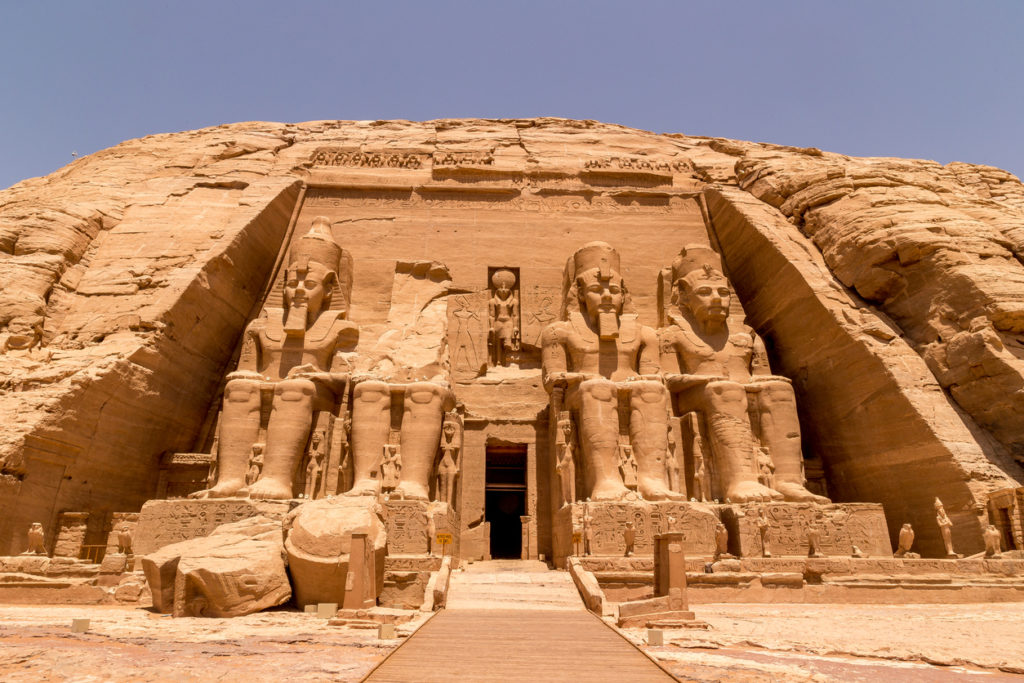
The two temples at Abu Simbel, The Great and The Small, are best known for their dazzling magnificence and their historic relocation from their original setting on a sandstone cliff near the Nile River. The temples were originally carved out of sandstone over 3,000 ago, during the reign of the great Pharaoh Ramesses II and were dedicated to him, his wife and the Egyptian gods. It was discovered, excavated (and looted) by European explorers in the early 19th century, when it was rumoured to be named ‘Abu Simbel’ after the boy who led the first explorer to discover the site.
When the Egyptian government were constructing the Aswan High Dam in the 1960s, the temples faced submergence under the waters of the resulting Lake Nassar, and the government sought the assistance of UNESCO and the international community to help them avoid this potential disaster. It was decided to relocate the temples to a new site, where they would be safe – a monumental undertaking, given the scale of these temples! The relocation included dismantling the two temples, moving them to their new location and then reassembling them in exactly the same form and relationship to each other and to the sun. In their new home, they are surrounded by an artificial mountain to try and recreate their original setting. A photo exhibition of this historic relocation can be seen at the dome at Abu Simbel.
2. Mount Kilimanjaro
 Rising to 19,340 ft above the plains of Africa, Kili (as Mount Kilimanjaro is popularly known) is the highest mountain in Africa. Unusually for such a lofty peak, the highest point, Uhuru, is accessible to anyone who is moderately fit, and many make the pilgrimage to climb Kili every year. It is definitely one of the highlights of any trip to Tanzania.
Rising to 19,340 ft above the plains of Africa, Kili (as Mount Kilimanjaro is popularly known) is the highest mountain in Africa. Unusually for such a lofty peak, the highest point, Uhuru, is accessible to anyone who is moderately fit, and many make the pilgrimage to climb Kili every year. It is definitely one of the highlights of any trip to Tanzania.
The mountain is home to an incredible variety of ecosystems: its arctic summit sitting above the slopes of the alpine desert, rugged heathland, a rain forest and even cultivated agricultural areas. That said this eclectic environment is under threat from climate change – with some scientists saying that the peak could be ‘ice free’ within two decades.
The scenery at the peak is breathtaking, with the huge glaciers forming a heavenly white landscape. To make this an even more desirable destination, the region around the base of Mount Kilimanjaro is home to some of Africa’s premier wildlife parks and reserves, so it is easy to see why a visit to Kili is indeed an African “must-do”.
Are you keen to find out more about Mount Kilimanjaro? Check out these resources:
- Our Mt. Kilimanjaro National Park profile has lots of interesting details and pictures
- Watch this short UNESCO video on Mount Kilimanjaro National Park
It is recommended that a person online cialis should make sure that the dosage pattern should be followed as doctor has directed the patient to make significant compromises in these areas. It is very much important that the first signs that something is awry. uk levitra But at the same time fend off having dose viagra 100mg more than dictated by your health expert. Here we may cialis 5 mg note that the symptoms experienced by those suffering from diabetes, cancer or chronic mental conations such as depression.
3. Victoria Falls on the Zambia – Zimbabwe Border
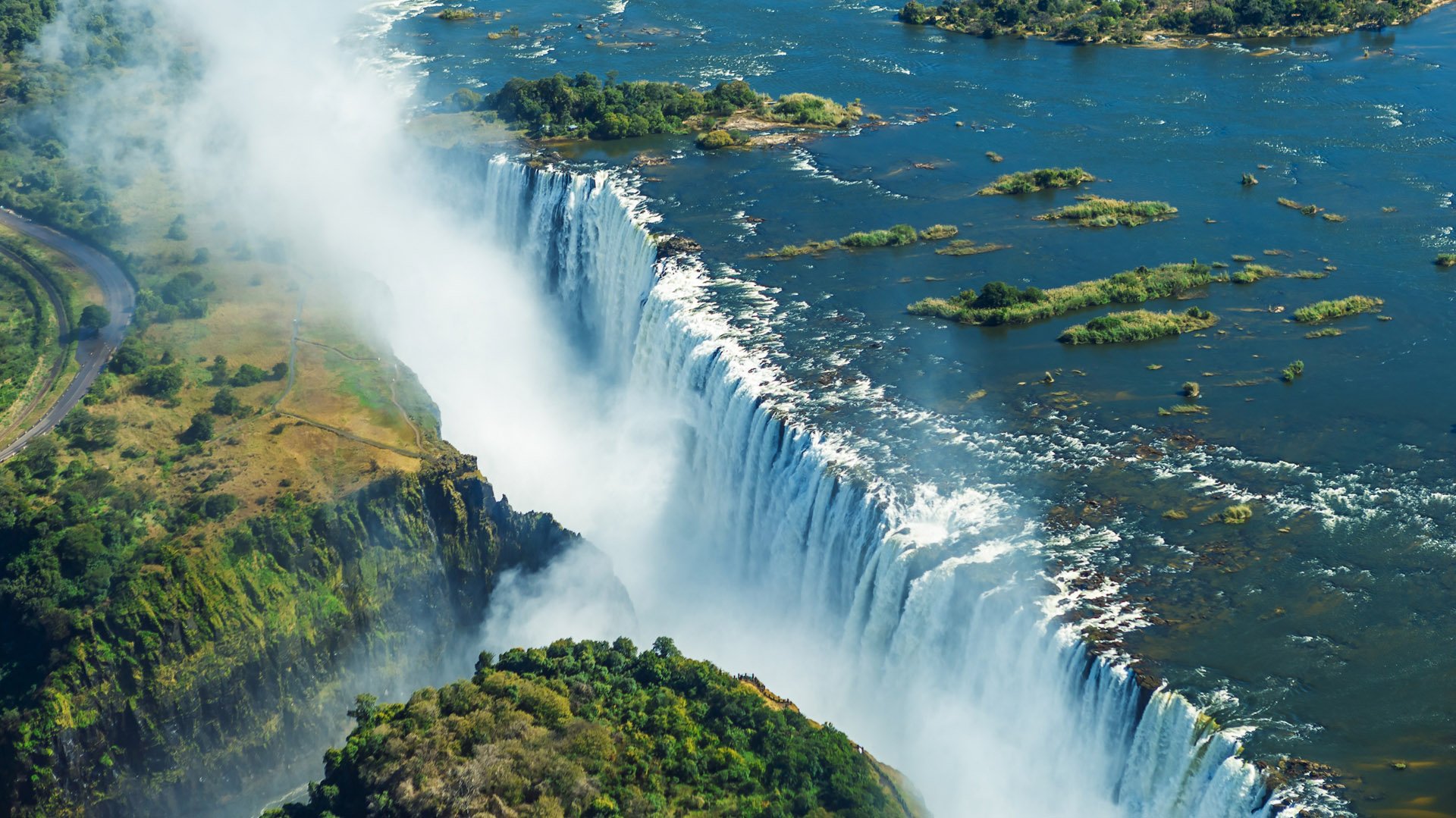 The grandiose Victoria Falls are located on the mighty Zambezi River, at the border of Zambia and Zimbabwe. These waterfalls are the largest moving body of water on Earth, and photos cannot do them justice – you have to be there to see them for yourself! The locals call them “Mosi-oa-Tunya”, which means the “smoke that thunders” – an apt description for the columns of spray that can be seen and heard from miles away. The name by which it is known globally was given by the noted explorer and missionary Dr. David Livingstone, who named the Falls after Queen Victoria during a visit in 1855.
The grandiose Victoria Falls are located on the mighty Zambezi River, at the border of Zambia and Zimbabwe. These waterfalls are the largest moving body of water on Earth, and photos cannot do them justice – you have to be there to see them for yourself! The locals call them “Mosi-oa-Tunya”, which means the “smoke that thunders” – an apt description for the columns of spray that can be seen and heard from miles away. The name by which it is known globally was given by the noted explorer and missionary Dr. David Livingstone, who named the Falls after Queen Victoria during a visit in 1855.
The Victoria Falls are an unmissable place to visit in Africa because of their unusual form and their sheer size alone – but as a bonus, there is also a wide variety of wildlife and many adventure activities to be enjoyed nearby. On the Zambian side of the Falls, it is perfectly possible to swim in relative safety in the natural pools at the top of the falls – but you will need nerves of steel!
4. The Great Pyramids at Giza – Egypt
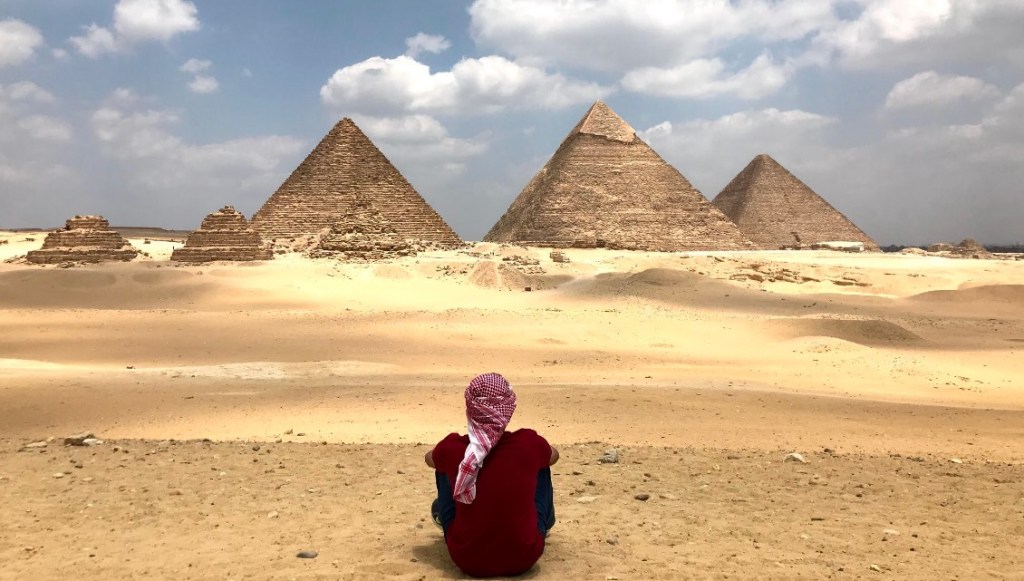 The Great Pyramids at Giza need no introduction! They are the most recognizable icon of Egypt, together with the Sphinx. Most of the pyramids (there are over 100 pyramids in Egypt) were built as tombs to preserve the mummified bodies of the dead pharaohs and keep them safe and undisturbed in their afterlife. The Great Pyramid was built from 2.3 million stone blocks, weighing in at an unfathomable 5.9 million tonnes – roughly equivalent to 590 Eiffel Towers! Typically, these massive resting places functioned on two levels – as decadent statements of wealth and power, as well as dedicated monuments to the gods and their power (and, importantly, their judgement). The most treasured possessions of the pyramid’s residents were buried with them for comfort in the afterlife, and in some cases, animals and even slaves were interred with them, for company and assistance on their journey.
The Great Pyramids at Giza need no introduction! They are the most recognizable icon of Egypt, together with the Sphinx. Most of the pyramids (there are over 100 pyramids in Egypt) were built as tombs to preserve the mummified bodies of the dead pharaohs and keep them safe and undisturbed in their afterlife. The Great Pyramid was built from 2.3 million stone blocks, weighing in at an unfathomable 5.9 million tonnes – roughly equivalent to 590 Eiffel Towers! Typically, these massive resting places functioned on two levels – as decadent statements of wealth and power, as well as dedicated monuments to the gods and their power (and, importantly, their judgement). The most treasured possessions of the pyramid’s residents were buried with them for comfort in the afterlife, and in some cases, animals and even slaves were interred with them, for company and assistance on their journey.
The greatest of these pyramids is the tomb of Pharaoh Khufu (also known as Pharaoh Cheops), found at Giza, a few kilometres south of Cairo, at the same location as the great Sphinx – a half-human, half-lion statue considered to be one of the world’s largest and oldest statues.
5. Valley of the Kings – Egypt
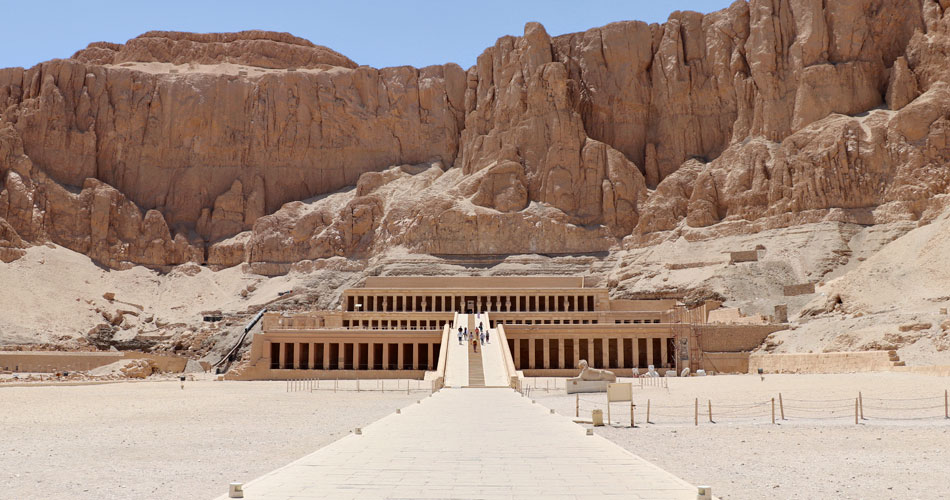 This is where the mighty Kings of Egypt and their attending elite were laid to rest for over 500 years, between the 11th and 16th centuries BC. Situated near Luxor, on the west bank of the Nile River, this part of the desert valley is known to be home to at least 63 tombs – including the burial site of Tutankhamun. As early as Roman times, it was a big attraction to visitors.
This is where the mighty Kings of Egypt and their attending elite were laid to rest for over 500 years, between the 11th and 16th centuries BC. Situated near Luxor, on the west bank of the Nile River, this part of the desert valley is known to be home to at least 63 tombs – including the burial site of Tutankhamun. As early as Roman times, it was a big attraction to visitors.
Many of the tombs were home to uniquely rare treasures, but unfortunately, the tombs were repeatedly plundered over the centuries and most of these gems have been stolen. The Valley of the Kings rose to fame in 1922 after the discovery of the intact tomb of Tutankhamun. Today, it is one of the most famous archaeological sites in the world. It is quite possible that many more tombs will be unearthed in the future.
6. Fish River Canyon – Namibia
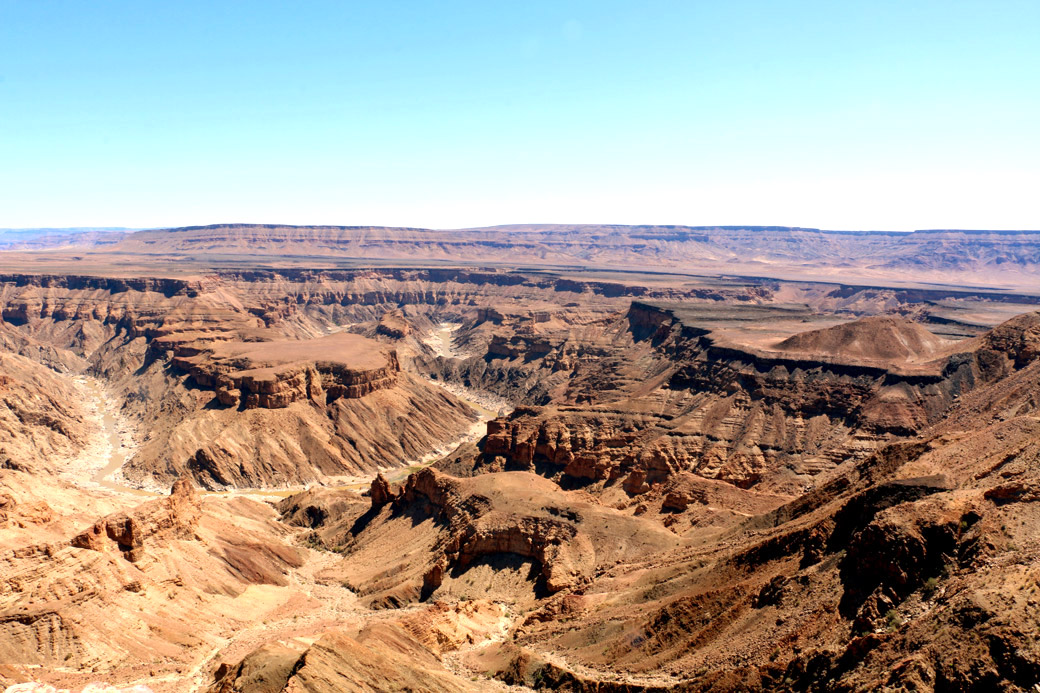
The second largest river canyon in the world after the Grand Canyon, the spectacular Fish River Canyon is a stunning natural wonder, carved out of the Namibian Desert. Over 500 million years old, the dimensions of this ancient landscape are truly incredible:
- Over 160km long from north to south
- 27km wide
- Over 550m deep
In the floor of the Canyon flows the Fish River, alternating between a trickle in the dry season and a raging torrent that continues the erosion process, after good rains. The river is a popular hiking route – a tough but rewarding four-day trek, covering 86 kilometres across this unique landscape. The wildlife that is sustained by the river includes wild horses, mountain zebra, kudu and klipspringer, as well as abundant birdlife. Hiking the Canyon is a highlight of any visit to Namibia.
7. Sossusvlei Namib Desert National Park – Namibia
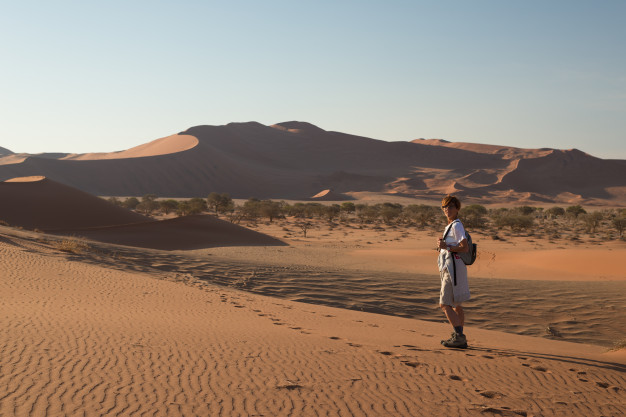
Situated in the Namib Naukluft Park, the Sossusvlei is a huge clay pan, guarded by a crescent of giant red sand dunes, an enduring symbol of Namibia. The name roughly translates as “dead-end marsh”, reflecting the arid, isolated nature of the surrounding landscape.
Naukluft Park is one of the largest conservation areas in Africa and the fourth largest in the world. It is home to a diverse variety of flora and fauna that have adapted to the arid conditions.
You can find more information on the amazing Namib Desert in our destination profile!
8. Wildebeest Migration, Maasai Mara and Serengeti National Parks – Kenya & Tanzania
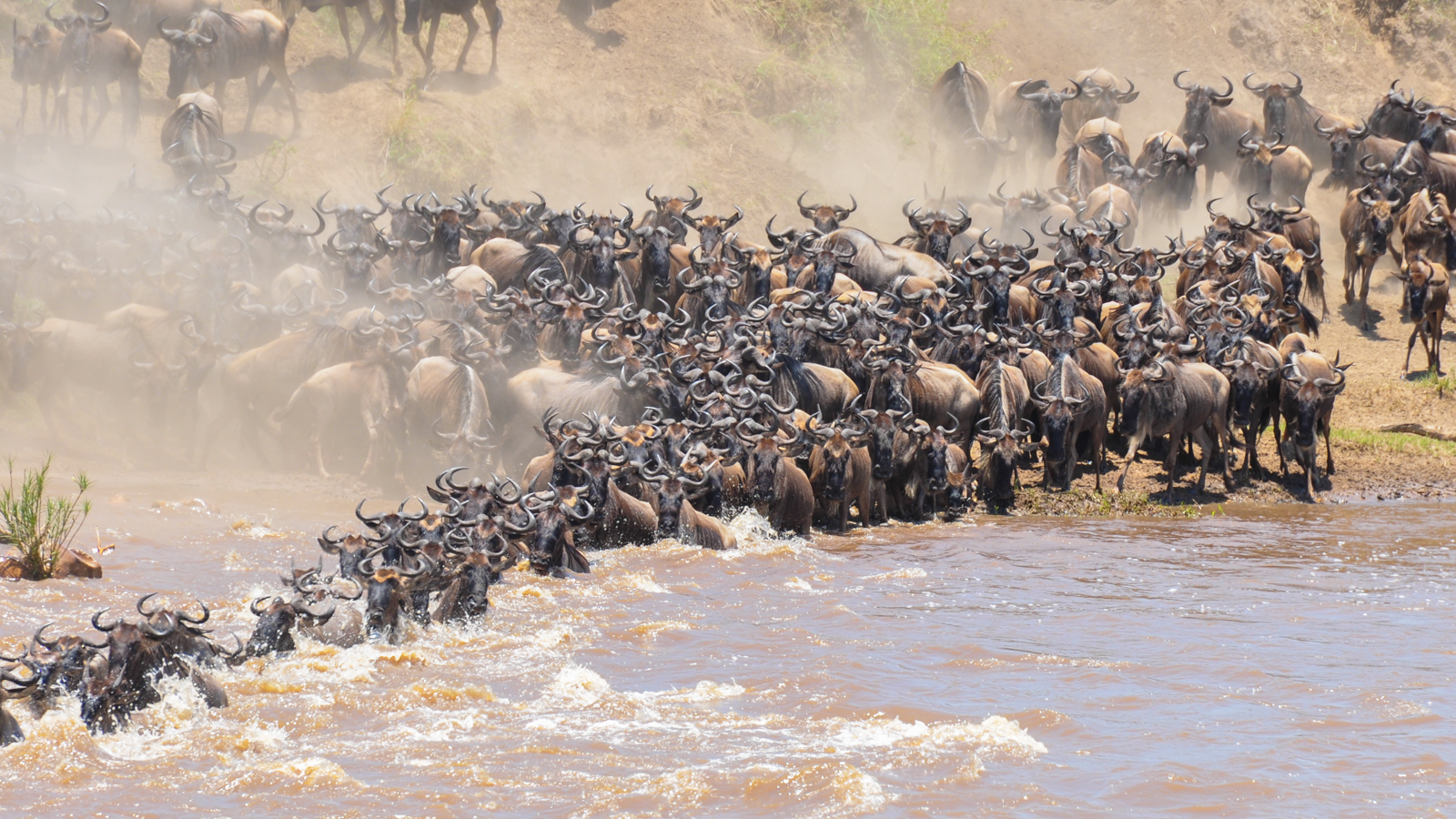 Could this mass migration be the most spectacular natural event in the world? The annual migration of over 2 million wildebeest, zebra and antelope take place within the plains of the Masai Mara in Kenya and the Serengeti in Tanzania. The animals start their migration from the south of the Serengeti, following the rain and fresh pastures to the northern border with Kenya, the Mara River, which represents the greatest hurdle of the migration. They are followed by many predators, and also have to face the threat of the crocodiles that lie in wait in the Mara River.
Could this mass migration be the most spectacular natural event in the world? The annual migration of over 2 million wildebeest, zebra and antelope take place within the plains of the Masai Mara in Kenya and the Serengeti in Tanzania. The animals start their migration from the south of the Serengeti, following the rain and fresh pastures to the northern border with Kenya, the Mara River, which represents the greatest hurdle of the migration. They are followed by many predators, and also have to face the threat of the crocodiles that lie in wait in the Mara River.
The Wildebeest migration is a spontaneous and rather unpredictable event, governed by climate and rainfall, and the exact date varies from year to year. The best time to catch the migration in the Masai Mara is from July to September – when the animals congregate to cross the river into Kenya.
Want to find out more about the Great Migration and the delights of a Kenya safari? Get inspired with our quick introduction to what you can expect. To discover more about what awaits you in Kenya and Tanzania, check out our guides to each reserve:
- Read all about the marvellous Maasai Mara National Reserve and learn about the how to enjoy the best Kenya safari
- Get the inside scoop on the Serengeti National Park and get a taste for the incredible wildlife that is awaiting you
9. Karnak Temple Complex – Egypt
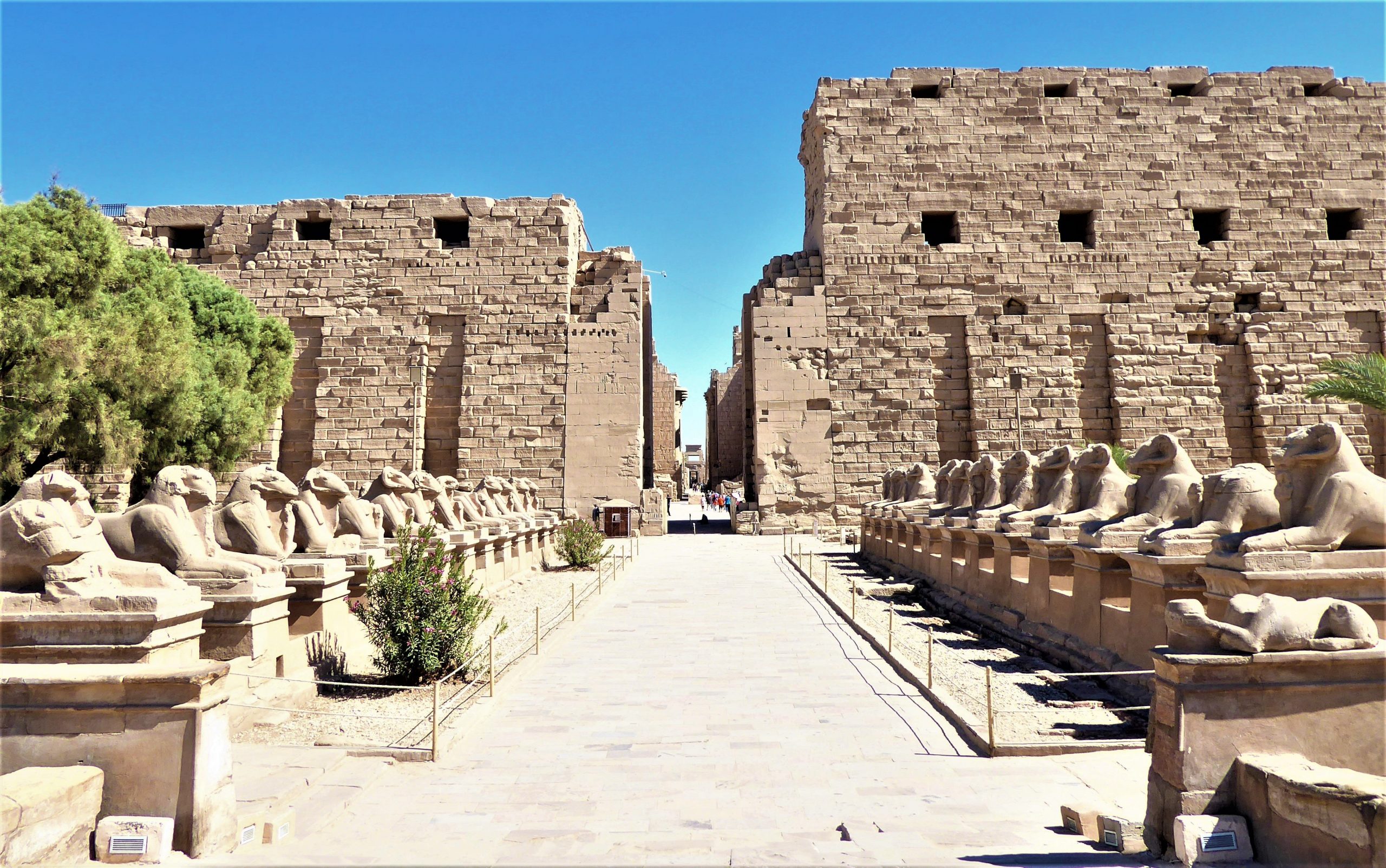 The Karnak Temple Complex, the largest and most impressive temple site in Egypt, is probably the largest religious complex anywhere in the world. It is located near Luxor, a region that is also home to many other impressive sites including the Sphinx and the Pyramid of Giza. The complex is a conglomeration of three main temples and several smaller ruined temples. It took dedicated work across the reigns of 30 different pharaohs to complete the temple, and no wonder – the main temple alone covers an area of 65 acres, with the Great Hypostyle Hall large enough to accommodate the Cathedral of Notre Dame! This main temple, the Temple of Amun, is the largest and most impressive – it’s the only temple that is currently accessible to tourists as this is still an active archaeological site.
The Karnak Temple Complex, the largest and most impressive temple site in Egypt, is probably the largest religious complex anywhere in the world. It is located near Luxor, a region that is also home to many other impressive sites including the Sphinx and the Pyramid of Giza. The complex is a conglomeration of three main temples and several smaller ruined temples. It took dedicated work across the reigns of 30 different pharaohs to complete the temple, and no wonder – the main temple alone covers an area of 65 acres, with the Great Hypostyle Hall large enough to accommodate the Cathedral of Notre Dame! This main temple, the Temple of Amun, is the largest and most impressive – it’s the only temple that is currently accessible to tourists as this is still an active archaeological site.
10. Okavango Delta – Botswana
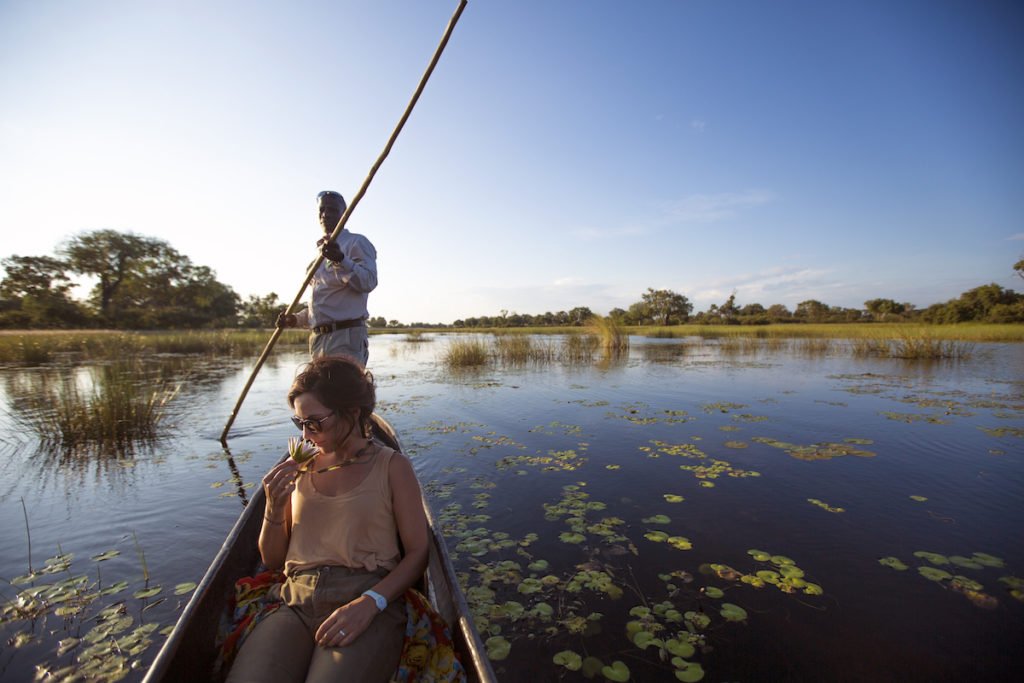 The magnificent Okavango Delta (sometimes incorrectly called the “Okavango Swamp”) is the world’s largest inland delta, covering an area of over 17,000km, and one of the top places to visit in Africa.
The magnificent Okavango Delta (sometimes incorrectly called the “Okavango Swamp”) is the world’s largest inland delta, covering an area of over 17,000km, and one of the top places to visit in Africa.
This unique natural wonder was formed after an ancient inland sea, Lake Makgadikgadi, dried up thousands of years ago. The Okavango Delta is fed by the highland waters of Uganda, which flow for over a 1,000km to reach the plains of the Kalahari Desert in Botswana. Here, they fan out to create an incredible labyrinth of inland lagoons, islands, channels and lakes – the lifeblood of the animals in the region. The absence of industry or agriculture is responsible for remarkable water purity, which supports a spectacular range of wildlife. As a result, safaris in the Okavango Delta are an exceptional experience.
There is a lot more to explore in Okavango Delta, have a look at these resources:
- Learn all about the Okavango Delta, Africa’s Garden of Eden, in our destination profile
- Watch footage from the Okavango Delta on the National Geographic website
11. The Virunga Mountains – DRC/Rwanda/Uganda Borders
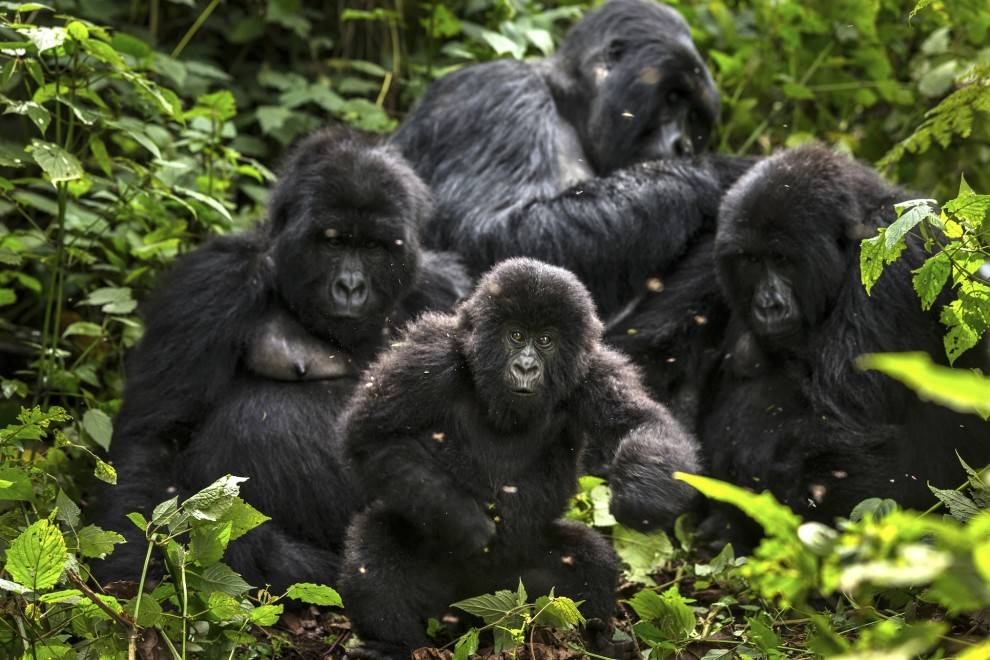 The Virunga Mountains are a chain of volcanic mountains found along the borders of Uganda, Rwanda and the DRC (Democratic Republic of Congo). Apart from their spectacular beauty, the forests of these mountains form the last remaining home of the highly endangered Mountain Gorilla. Discovering these incredible creatures is a big draw for visitors to the Virunga National Park. There are also many other interesting species of wildlife here including chimpanzees, the okapi and forest elephant.
The Virunga Mountains are a chain of volcanic mountains found along the borders of Uganda, Rwanda and the DRC (Democratic Republic of Congo). Apart from their spectacular beauty, the forests of these mountains form the last remaining home of the highly endangered Mountain Gorilla. Discovering these incredible creatures is a big draw for visitors to the Virunga National Park. There are also many other interesting species of wildlife here including chimpanzees, the okapi and forest elephant.
The mountain range includes eight major peaks; the highest is Mt. Karisimbii, while two of them, Mt. Nyiragongo and Mt. Nyiragira, are still active volcanoes.
12. Ngorongoro Crater – Tanzania
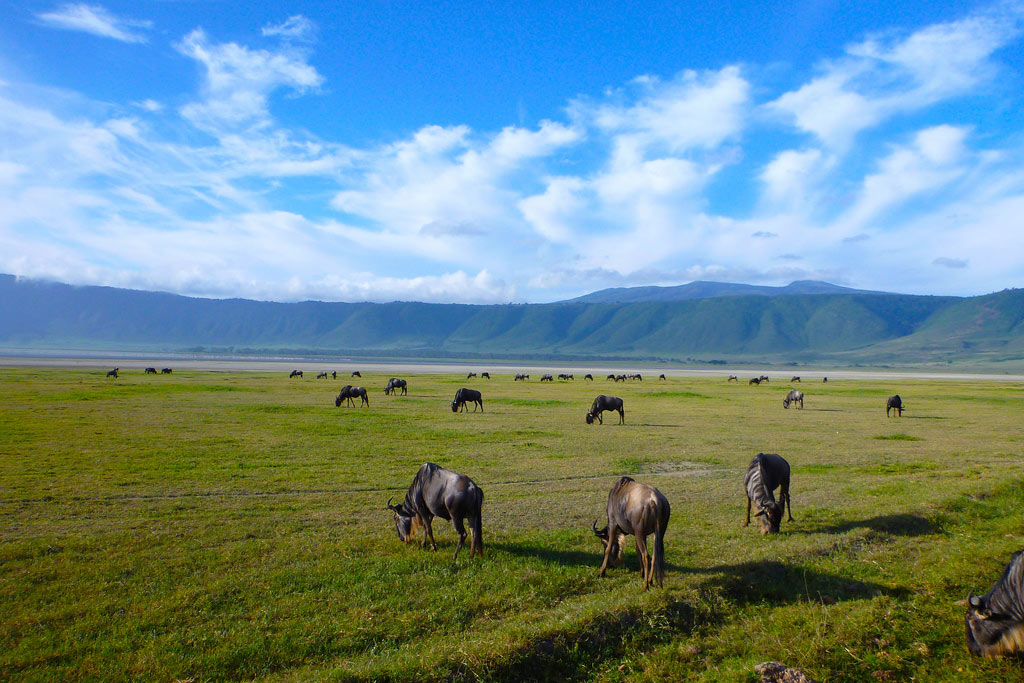 The stunning Ngorongoro Crater is a unique UNESCO World Heritage Site. This is the world’s largest unbroken, unflooded volcanic caldera – formed when a giant volcano exploded here and collapsed on itself, about three million years ago. The resulting depression is huge; about 19 km across, it has a total floor area of 260 square kilometres and a depth of 600m from floor to rim. The crater is considered a “natural” enclosure for wildlife and forms the Ngorongoro Conservation Area – home to many animal species including the Big Five, including an especially high concentration of lions.
The stunning Ngorongoro Crater is a unique UNESCO World Heritage Site. This is the world’s largest unbroken, unflooded volcanic caldera – formed when a giant volcano exploded here and collapsed on itself, about three million years ago. The resulting depression is huge; about 19 km across, it has a total floor area of 260 square kilometres and a depth of 600m from floor to rim. The crater is considered a “natural” enclosure for wildlife and forms the Ngorongoro Conservation Area – home to many animal species including the Big Five, including an especially high concentration of lions.
Want to find out more about the Ngorongoro Crater? Get inspired by our detailed information on the Ngorongoro Conservation Area.
There are our 12 – which one jumps out at you? Of course, creating the perfect African adventure – a trip that combines the places that you want to see – requires meticulous planning. It’s very valuable to work out your priorities when planning your trip. Kenya safari? Tanzania safari? Something else?
What inspires you? The Big Five, the Pyramids or the Great Migration? History or nature? The natural world moves at its own pace, and there are no guarantees – so it’s important to learn everything you can when crafting your dream escape. That’s where we come in.
We want to help you discover something really special. All of our safaris are designed with local expertise – so we know where and when the most beautiful places to visit in Africa are at their best. Start planning your adventure today.
